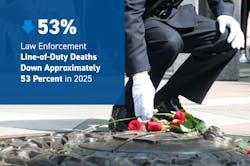NLEOMF CEO Says Culture Shift May Play Role in Steep Decline of LODDs
What to Know
-
The National Law Enforcement Officers Memorial Fund's 2025 Mid-Year Law Enforcement Officers Fatalities Report, shows that line-of-duty in the first half of the year have decreased 53% compared to the same period last year.
-
Preliminary data revealed that 42 federal, state, county, municipal and officers from the U.S. Territories have died in the line-of-duty in the first half of 2025 compared to the 89 officers who died in the first half of 2024.
-
National Law Enforcement Officers Memorial Fund CEO Bill Alexander noted that if the trend continues in the second half of 2025, there would be fewer than 100 line of duty deaths for the first time since 1943.
-
Alexander says that he believes that the change in political climate in the country may play a role in the decline of line of duty deaths.
WASHINGTON, D.C. – On Tuesday (July 8), the National Law Enforcement Officers Memorial Fund (NLEOMF) released its 2025 Mid-Year Law Enforcement Officers Fatalities Report, which shows that line-of-duty in the first half of the year have decreased 53% compared to the same period last year.
Preliminary data revealed that 42 federal, state, county, municipal and officers from the U.S. Territories have died in the line-of-duty in the first half of 2025 compared to the 89 officers who died in the first half of 2024.
“We never want to use the words ‘good news’ when we're talking about even a single police officer dying in the line of duty, but I would call this trend a very positive direction for law enforcement across the nation,” National Law Enforcement Officers Memorial Fund CEO Bill Alexander told Officer.com.
Alexander noted that if the trend continues for the second half of 2025, there would be fewer than 100 line of duty deaths for the first time since 1943. Earlier this year, the NLEOMF and the United States Department of Transportation’s National Highway Traffic Safety Administration (NHTSA) announced a collaboration with the law enforcement training organization known as “Below 100,” which has been providing important safety training created to keep law enforcement officers safe since 2010.
Deaths down in every category
Not only were the overall LODDs down in the mid-year report, but so were deaths in the three categories tracked by the NLEOMF. Firearms-related fatalities claimed the lives of 22 officers in 2025, represents a decrease of 21% from the 28 officers killed by gunfire in the first half of 2024 and was the leading cause of death, according to the report.
There were 13 traffic-related fatalities in the first half of 2025; marking is a 50% decrease compared to the first half of 2024, which had a total of 26 deaths.
The ‘other’ category contains a wide variety of health-related deaths and other causes of line-of-duty fatalities. Seven officer deaths are listed in the “other” category versus 35 for the same period last year, which represents an 80% decrease from last year.
Demographics
Of the 42 line of duty deaths counted in the report, 39 were male, while three were female. The average age of the fallen officers is 43, with an average of 13 years of service. On average, the officers left behind two children. Texas and California have the highest number of law enforcement fatalities of all U.S. States, with five line-of-duty deaths each. 26 states have not lost an officer so far in 2025.
Possible contributing factors
Alexander says that while there are no concrete answers to why the mid-year number of LODDs is down so dramatically, he believes a number of factors have played a role. The NLEOMF has always focused on solutions to why officers are dying in the line of duty, but over the last decade, the organization has really expanded its mission through different programs and educational efforts including the Destination Zero National Officer Safety and Wellness Awards, its partnership with the NHTSA, as well as numerous programs presented by the National Law Enforcement Museum.
“We as an organization have been trying to both create and then find and highlight programs and best practices from across the country which we hope will make it safer for the men and women out there on the streets still doing the job,” he says, noting that groups such as the International Association of Chiefs of Police (IACP), the Police Executive Research Forum (PERF) and the Fraternal Order of Police (FOP) have played a part in addressing officer safety and wellness in law enforcement. “I hope that sort of collective effort to come up with better training protocols and better practices to keep the men and women in law enforcement safe are reflected to some degree in these numbers.”
He stressed that while the vigilance of different groups, along with officers and law enforcement agencies throughout the country, has likely played a big part in driving down the number of LODDs, that he suspects there are other factors at work as well. “I also think anecdotally there is something in the water in terms of the real shift that I think I could make a strong argument for over the last 6 to 8 months. I try to shy away from saying things politically, but certainly a new administration is in (the White House) and while I don't equate it to politics, I do think that there has been something of a shift in the tone,” he says, adding that the rhetoric and conversation around law enforcement from elected leaders, the media and on the internet has turned in a more positive direction.
“I would like to think that I could make something of a compelling argument that it is starting to influence public behavior in these law enforcement interactions. Not universally, not that everyone all of a sudden is respectful of men and women in uniform, but enough of those encounters might be changing or shifting ever so slightly that people are cognizant to some degree that law and order to varying degrees has come back; that there is a penalty if you step out of the bounds of cultural norms and break laws,” he says. “My hope is that is being reflected to some degree in these fewer officer deaths that maybe officers, by virtue of that change, are having to use force less frequently, are finding themselves in situations that are not quite as dangerous, and that people are to some degree maybe complying more often with verbal commands and the instructions given by police officers.
“Clearly, it's not a universal fix-all by virtue of this change politically, but I think something there is likely contributing to the overall reduction.”
About the Author
Paul Peluso
Editor
Paul Peluso is the Managing Editor of OFFICER Magazine and has been with the Officer Media Group since 2006. He began as an Associate Editor, writing and editing content for Officer.com. Previously, Paul worked as a reporter for several newspapers in the suburbs of Baltimore, MD.


